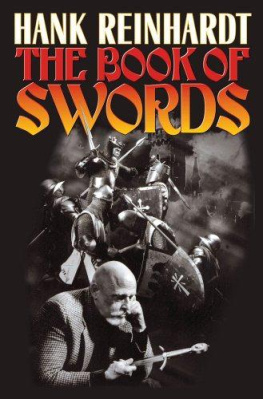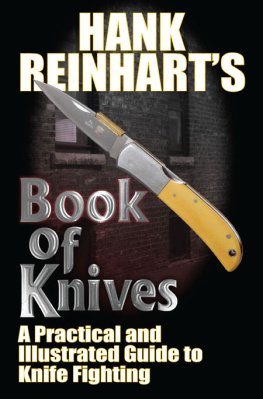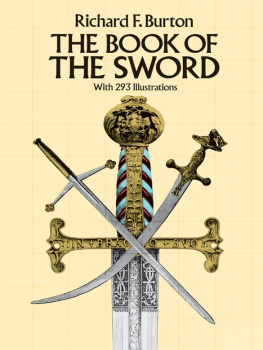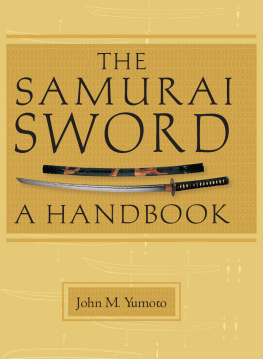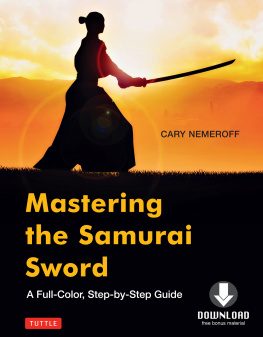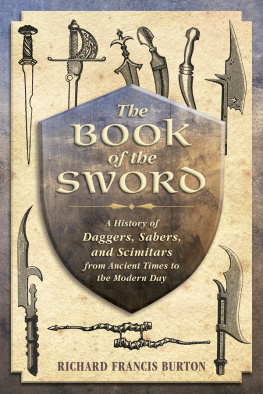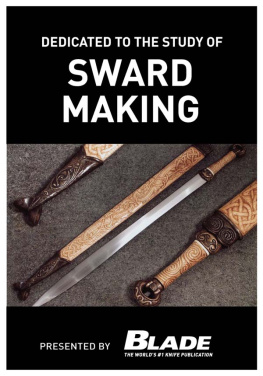Hank Reinhardt's
THE BOOK OF THE SWORD
Hank Reinhardt
Copyright 2009 by Hank Reinhardt
All rights reserved, including the right to reproduce this book or portions thereof in any form.
A Baen Books Original
Baen Publishing Enterprises
P.O. Box 1403
Riverdale, NY 10471
www.baen.com
ISBN 10: 1-4391-3282-8
ISBN-13: 978-1-4391-3282-1
First printing, August 2009
Distributed by Simon & Schuster
1230 Avenue of the Americas
New York, NY 10020
Library of Congress Cataloging-in-Publication Data
t/k
Pages by Joy Freeman (www.pagesbyjoy.com)
Printed in the United States of America
Introduction
The sword is the most revered of all of man's weapons. Although the club is older, the knife more universal, and the firearm much more efficient, it is to the sword that the most decoration, myth, mysticism and reverence has been given.
The sword has been the symbol of Justice, of Vengeance, and of Mercy. The katana has been called "The Soul of the Samurai." The Vikings lavished love, care, and attached wonderful names to their weapons. No one artifact has so captured the imagination as has the sword. It captured my imagination when I was seven years old, and it still fascinates me some sixty years later.
When I was twelve years old, my brother-in-law returned from the WWII in the South Pacific and gave me two Japanese bayonets. With a neighborhood kid I promptly went out and started fighting with them. The result was that I had two bayonets with blades that looked like hacksaws from the nicks. This clearly was not the way it happened in books and movies! This was the beginning of a lifelong quest to find out how swords were actually used in combat.
About the same time I started fighting with broomsticks and garbage can tops. This was a lot of fun until the mothers started screaming about knots on little darlings' heads. They paid no attention when it was explained that the recipient failed to parry. Regretfully, irate parents put an end to the blossoming experiments on the use of the sword. Alas, thus is serious scientific study forestalled....
I continued my solo study of the subject matter and managed to buy various small edged weapons while still a teenager. My first was a kukri, a knife used by the Gurkhas of Nepal. Serious collecting didn't start until I was twenty-three, in the U.S. Army and stationed in Germany. There I ran across a Swiss short sword circa 1840 and a rapier (in very poor condition), circa 1650. I bought both, and the craze was on.
While in Germany I traveled extensively, visiting many museums, and frequently talking with armor curators (who rarely found anyone who shared their passion). After my separation from the army, and back in the States, I continued my studying and collecting. [Editor's Note: Hank's collection of antique and reproduction weapons at the time of his death included over 600 items; his collection of books on arms and armor included over 700 volumes.]
In 1984 Bill Adams and I started up Museum Replicas, Ltd., and issued a catalog devoted to the sale of replica arms and armor. This allowed me greater latitude in my studies, and I began to travel much more, visiting even more museums in Europe and Asia. Now, my interest in arms and armor wasn't limited to European items, but embraced Asian, African and Polynesian as well.

Indonesian kris, circa 1900, 30 inches overall length. HRC550.
My research into the actual use of the weapons has been helped a great deal by the study of original sources, such as Icelandic sagas, Froissart's Chronicles and many medieval manuscripts. In addition to this I have engaged in many experiments, such as cutting into mail, cutting armor, and testing weapons to see just how effective they are. Along with several friends, I have engaged in a great deal of sparring combat. However, this time we used padded weapons. (Wives can put an end to scientific inquiry as well as parents.)
There have been many excellent books on the sword, particularly its development and history. The European sword has been well studied, so too the Eastern weapons, particularly the Japanese katana. Other authors have approached the study of the sword from a historical viewpoint, from Ewart Oakeshott, who wrote with an eye to classifying different types of medieval swords, to Richard Burton, describing swords around the world.
So it may be presumptuous of me to feel that I can add to the work. But I do feel that my own experimentation and its results are well worth recording. What I intend to show in this volume is the result of a lifetime's practical research into swords, how they were made and how they were employed, and to correct some of the incredible amount of misinformation given about swords, all types of swords.
As our society has grown more and more advanced, and more reliant on technology, there has been an increased interest in the weapons of the past. The romance of the sword is very much alive, both in the East and the West.
But as our technology has improved our living conditions it has also obscured our vision of the past. Not only is our vision obscured by distance, but movies, books and fiction of all types have romanticized the past, and particularly the sword, beyond all recognition of the real thing.
In order to understand the sword it is necessary for us to understand the material from which it is made. This appears to be so basic an idea that it isn't worth the effort to write down or even read it. But the truth is that very few people understand iron and its physical properties, and in order to understand the sword, and its use, it is necessary to understand iron and how the weapons were made then, and now.
Let me explain. In my time, I have been asked if the Vikings used stainless steel in their swords, as it wouldn't rust on their long voyages. I had one person write and tell me that he had left his sword outside in the rain, and it had developed a "fungus," funny red splotches on the blade! Since stainless steel was not developed until the 20th century, and ferric oxide (known as "rust") has been around since the beginning of time, you can understand my feelings that this ignorance should be dealt with.
Curiously enough, it wasn't until 1786 that de Morveau proved that it was carbon that turned iron into steel. (Carbon was only discovered about ten to twelve years previous to that.) Before then it was thought that steel was the pure form of iron, and that by using coke, coal, etc. and heating the iron white hot, that impurities were being burnt out, instead of vice versa.
In order to understand swords, how they are used, what they can and can't do, it is necessary to know something about iron and steel. Years ago, when swords were in actual use, this would not be necessary. People were familiar with iron implements and knew what to expect. However, this is not true today. Movies, television and books have all contributed to this lack of knowledge. The most outrageous comments are made and believed, and these comments are made by people who have no knowledge of the subject! Sometimes these "experts" will deliberately lie in order to dramatize something. For an example, in the movie of Shakespeare's Henry V , director Sir Lawrence Olivier has a scene with a knight being hoisted up by a crane and lowered onto his horse. When it was pointed out that this was not only incorrect, but actually ridiculous, Olivier replied that he didn't care, it made a good scene!
But this is just one of many such errors that have been perpetuated in modern times. Swords are shown slammed edge on against each other with no damage, smashed into concrete pillars, and cutting steel and stone with ease. I think my favorite myth is that of the Japanese katana that cut a machine gun barrel in half.
Next page
